Input interpretation

H_2O (water) + NaCl (sodium chloride) ⟶ HCl (hydrogen chloride) + NaOH (sodium hydroxide)
Balanced equation
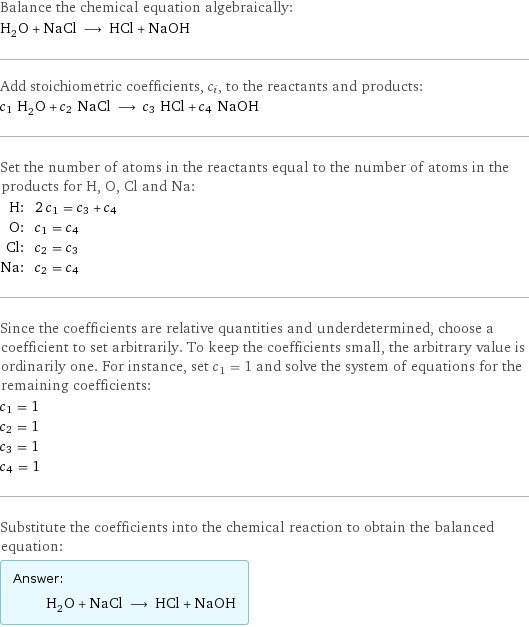
Balance the chemical equation algebraically: H_2O + NaCl ⟶ HCl + NaOH Add stoichiometric coefficients, c_i, to the reactants and products: c_1 H_2O + c_2 NaCl ⟶ c_3 HCl + c_4 NaOH Set the number of atoms in the reactants equal to the number of atoms in the products for H, O, Cl and Na: H: | 2 c_1 = c_3 + c_4 O: | c_1 = c_4 Cl: | c_2 = c_3 Na: | c_2 = c_4 Since the coefficients are relative quantities and underdetermined, choose a coefficient to set arbitrarily. To keep the coefficients small, the arbitrary value is ordinarily one. For instance, set c_1 = 1 and solve the system of equations for the remaining coefficients: c_1 = 1 c_2 = 1 c_3 = 1 c_4 = 1 Substitute the coefficients into the chemical reaction to obtain the balanced equation: Answer: | | H_2O + NaCl ⟶ HCl + NaOH
Structures

+ ⟶ +
Names

water + sodium chloride ⟶ hydrogen chloride + sodium hydroxide
Reaction thermodynamics
Enthalpy
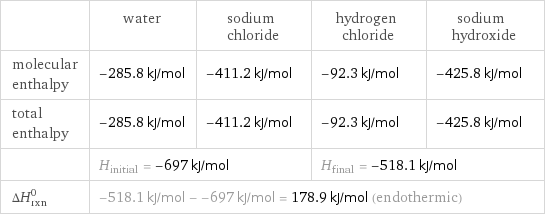
| water | sodium chloride | hydrogen chloride | sodium hydroxide molecular enthalpy | -285.8 kJ/mol | -411.2 kJ/mol | -92.3 kJ/mol | -425.8 kJ/mol total enthalpy | -285.8 kJ/mol | -411.2 kJ/mol | -92.3 kJ/mol | -425.8 kJ/mol | H_initial = -697 kJ/mol | | H_final = -518.1 kJ/mol | ΔH_rxn^0 | -518.1 kJ/mol - -697 kJ/mol = 178.9 kJ/mol (endothermic) | | |
Gibbs free energy
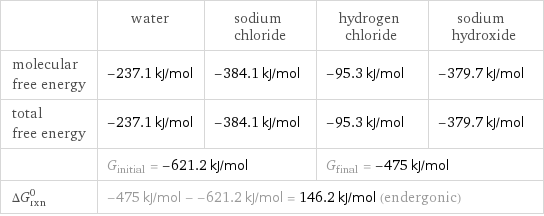
| water | sodium chloride | hydrogen chloride | sodium hydroxide molecular free energy | -237.1 kJ/mol | -384.1 kJ/mol | -95.3 kJ/mol | -379.7 kJ/mol total free energy | -237.1 kJ/mol | -384.1 kJ/mol | -95.3 kJ/mol | -379.7 kJ/mol | G_initial = -621.2 kJ/mol | | G_final = -475 kJ/mol | ΔG_rxn^0 | -475 kJ/mol - -621.2 kJ/mol = 146.2 kJ/mol (endergonic) | | |
Entropy
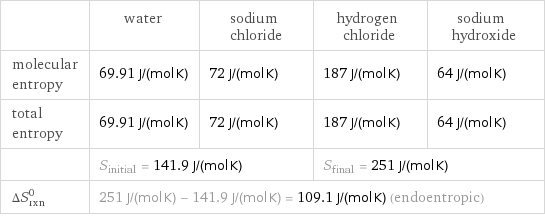
| water | sodium chloride | hydrogen chloride | sodium hydroxide molecular entropy | 69.91 J/(mol K) | 72 J/(mol K) | 187 J/(mol K) | 64 J/(mol K) total entropy | 69.91 J/(mol K) | 72 J/(mol K) | 187 J/(mol K) | 64 J/(mol K) | S_initial = 141.9 J/(mol K) | | S_final = 251 J/(mol K) | ΔS_rxn^0 | 251 J/(mol K) - 141.9 J/(mol K) = 109.1 J/(mol K) (endoentropic) | | |
Equilibrium constant
![Construct the equilibrium constant, K, expression for: H_2O + NaCl ⟶ HCl + NaOH Plan: • Balance the chemical equation. • Determine the stoichiometric numbers. • Assemble the activity expression for each chemical species. • Use the activity expressions to build the equilibrium constant expression. Write the balanced chemical equation: H_2O + NaCl ⟶ HCl + NaOH Assign stoichiometric numbers, ν_i, using the stoichiometric coefficients, c_i, from the balanced chemical equation in the following manner: ν_i = -c_i for reactants and ν_i = c_i for products: chemical species | c_i | ν_i H_2O | 1 | -1 NaCl | 1 | -1 HCl | 1 | 1 NaOH | 1 | 1 Assemble the activity expressions accounting for the state of matter and ν_i: chemical species | c_i | ν_i | activity expression H_2O | 1 | -1 | ([H2O])^(-1) NaCl | 1 | -1 | ([NaCl])^(-1) HCl | 1 | 1 | [HCl] NaOH | 1 | 1 | [NaOH] The equilibrium constant symbol in the concentration basis is: K_c Mulitply the activity expressions to arrive at the K_c expression: Answer: | | K_c = ([H2O])^(-1) ([NaCl])^(-1) [HCl] [NaOH] = ([HCl] [NaOH])/([H2O] [NaCl])](../image_source/968fc9318b3ec3e727d4e81b49b3f649.png)
Construct the equilibrium constant, K, expression for: H_2O + NaCl ⟶ HCl + NaOH Plan: • Balance the chemical equation. • Determine the stoichiometric numbers. • Assemble the activity expression for each chemical species. • Use the activity expressions to build the equilibrium constant expression. Write the balanced chemical equation: H_2O + NaCl ⟶ HCl + NaOH Assign stoichiometric numbers, ν_i, using the stoichiometric coefficients, c_i, from the balanced chemical equation in the following manner: ν_i = -c_i for reactants and ν_i = c_i for products: chemical species | c_i | ν_i H_2O | 1 | -1 NaCl | 1 | -1 HCl | 1 | 1 NaOH | 1 | 1 Assemble the activity expressions accounting for the state of matter and ν_i: chemical species | c_i | ν_i | activity expression H_2O | 1 | -1 | ([H2O])^(-1) NaCl | 1 | -1 | ([NaCl])^(-1) HCl | 1 | 1 | [HCl] NaOH | 1 | 1 | [NaOH] The equilibrium constant symbol in the concentration basis is: K_c Mulitply the activity expressions to arrive at the K_c expression: Answer: | | K_c = ([H2O])^(-1) ([NaCl])^(-1) [HCl] [NaOH] = ([HCl] [NaOH])/([H2O] [NaCl])
Rate of reaction
![Construct the rate of reaction expression for: H_2O + NaCl ⟶ HCl + NaOH Plan: • Balance the chemical equation. • Determine the stoichiometric numbers. • Assemble the rate term for each chemical species. • Write the rate of reaction expression. Write the balanced chemical equation: H_2O + NaCl ⟶ HCl + NaOH Assign stoichiometric numbers, ν_i, using the stoichiometric coefficients, c_i, from the balanced chemical equation in the following manner: ν_i = -c_i for reactants and ν_i = c_i for products: chemical species | c_i | ν_i H_2O | 1 | -1 NaCl | 1 | -1 HCl | 1 | 1 NaOH | 1 | 1 The rate term for each chemical species, B_i, is 1/ν_i(Δ[B_i])/(Δt) where [B_i] is the amount concentration and t is time: chemical species | c_i | ν_i | rate term H_2O | 1 | -1 | -(Δ[H2O])/(Δt) NaCl | 1 | -1 | -(Δ[NaCl])/(Δt) HCl | 1 | 1 | (Δ[HCl])/(Δt) NaOH | 1 | 1 | (Δ[NaOH])/(Δt) (for infinitesimal rate of change, replace Δ with d) Set the rate terms equal to each other to arrive at the rate expression: Answer: | | rate = -(Δ[H2O])/(Δt) = -(Δ[NaCl])/(Δt) = (Δ[HCl])/(Δt) = (Δ[NaOH])/(Δt) (assuming constant volume and no accumulation of intermediates or side products)](../image_source/668e993fcec5143d0d033d78cb3fe4a6.png)
Construct the rate of reaction expression for: H_2O + NaCl ⟶ HCl + NaOH Plan: • Balance the chemical equation. • Determine the stoichiometric numbers. • Assemble the rate term for each chemical species. • Write the rate of reaction expression. Write the balanced chemical equation: H_2O + NaCl ⟶ HCl + NaOH Assign stoichiometric numbers, ν_i, using the stoichiometric coefficients, c_i, from the balanced chemical equation in the following manner: ν_i = -c_i for reactants and ν_i = c_i for products: chemical species | c_i | ν_i H_2O | 1 | -1 NaCl | 1 | -1 HCl | 1 | 1 NaOH | 1 | 1 The rate term for each chemical species, B_i, is 1/ν_i(Δ[B_i])/(Δt) where [B_i] is the amount concentration and t is time: chemical species | c_i | ν_i | rate term H_2O | 1 | -1 | -(Δ[H2O])/(Δt) NaCl | 1 | -1 | -(Δ[NaCl])/(Δt) HCl | 1 | 1 | (Δ[HCl])/(Δt) NaOH | 1 | 1 | (Δ[NaOH])/(Δt) (for infinitesimal rate of change, replace Δ with d) Set the rate terms equal to each other to arrive at the rate expression: Answer: | | rate = -(Δ[H2O])/(Δt) = -(Δ[NaCl])/(Δt) = (Δ[HCl])/(Δt) = (Δ[NaOH])/(Δt) (assuming constant volume and no accumulation of intermediates or side products)
Chemical names and formulas

| water | sodium chloride | hydrogen chloride | sodium hydroxide formula | H_2O | NaCl | HCl | NaOH Hill formula | H_2O | ClNa | ClH | HNaO name | water | sodium chloride | hydrogen chloride | sodium hydroxide
Substance properties
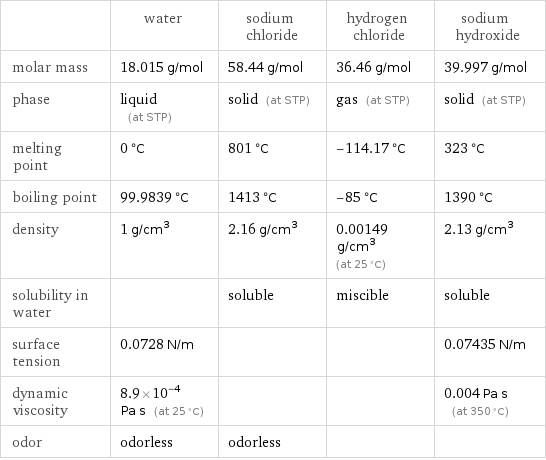
| water | sodium chloride | hydrogen chloride | sodium hydroxide molar mass | 18.015 g/mol | 58.44 g/mol | 36.46 g/mol | 39.997 g/mol phase | liquid (at STP) | solid (at STP) | gas (at STP) | solid (at STP) melting point | 0 °C | 801 °C | -114.17 °C | 323 °C boiling point | 99.9839 °C | 1413 °C | -85 °C | 1390 °C density | 1 g/cm^3 | 2.16 g/cm^3 | 0.00149 g/cm^3 (at 25 °C) | 2.13 g/cm^3 solubility in water | | soluble | miscible | soluble surface tension | 0.0728 N/m | | | 0.07435 N/m dynamic viscosity | 8.9×10^-4 Pa s (at 25 °C) | | | 0.004 Pa s (at 350 °C) odor | odorless | odorless | |
Units
